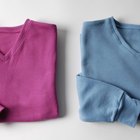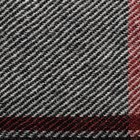Wool is a staple fiber found in fall and winter clothing, most often used in the production of coats, sweaters, socks, and suits. Beautiful and durable, it has the ability to keep you warm when the temperatures plummet. However, in spite of all its merits, it does have disadvantages which include cost, comfort, care and storage.
Cost
A fine wool sweater may cost two to three times more than one constructed of synthetic fibers. If paying the extra cost for wool, apply it to classic wardrobe staples that will last a long time, such as business wear, outerwear, and perennial accessories like scarves and light layers. For trendy items you will discard at the end of the season, opt for less expensive fibers to avoid frustration when the garments go out of style.
Comfort
Some varieties of wool can be very itchy to sensitive skin. Lower quality woolens are composed of shorter, coarser fibers with many more ends to stick out and cause irritation. For a more comfortable wear, opt for sweaters crafted from softer wools like Merino.
Care and Storage
Wool can be easily stained in the course of daily wear. It also tends to absorb odors from cooking, cigarette smoke and long-term storage. To protect your fine wool clothing from damage, avoid wearing against your bare skin, promptly spot clean any stains, and make sure to store in a well-ventilated area. To prevent moths from eating your wool sweaters, use mothballs or cedar drawer liners to repel these insects. But beware -- wool garments can sometimes absorb the scent of cedar or mothballs.
Dry Cleaning
Wool garments will shrink when washed and dried by machine. To safely clean fine woolens, gently wash them by hand or take them to the dry cleaner. This unfortunately means spending more money and time as compared to a less sensitive fabric.
Related Articles

Microfiber vs. Cotton Clothes

Can a Wool Coat Be Worn in the Rain?

How to Keep a Fleece-Lined Jacket From ...

Care of Mohair Fabric

How to Preserve Moleskin

The Care of Plisse Fabric

Linen vs. Wool Blazer

How to Soften Leather Jackets

How to Get Rid of the Odd Smell in a ...

How to Store Cashmere Sweaters

How to Get the Stiffness Out of ...

Types of Linen Fabric

Advantages & Disadvantages of Natural ...

My Legs Itch When I Wear Pantyhose

How to Wash Lululemon Pants

Differences Between Polyester and Nylon ...

What Are Persian Lamb Coats?

How to Get Wrinkles Out of Nylon ...

How to Care for Merino Wool

How Fast Does Cooked Spaghetti Squash ...
References
Writer Bio
Jean La Rue has been contributing to online publications since 2006. Her articles cover a broad range of topics, including law, politics, savings and investments, pet care, gardening and heirloom recipes. La Rue is an alumna of Washington State University, graduating with a Bachelor of Science in criminal justice.